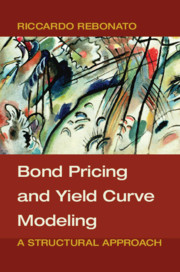Book contents
- Frontmatter
- Dedication
- Contents
- Acknowledgements
- Symbols and Abbreviations
- Part I The Foundations
- Part II The Building Blocks: A First Look
- Part III The Conditions of No-Arbitrage
- Part IV Solving the Models
- Part V The Value of Convexity
- Part VI Excess Returns
- Part VII What the Models Tell Us
- 30 The Doubly Mean-Reverting Vasicek Model
- 31 Real Yields, Nominal Yields and Inflation: The D'Amico–Kim–Wei Model
- 32 From Snapshots to Structural Models: The Diebold–Rudebusch Approach
- 33 Principal Components as State Variables of Affine Models: The PCA Affine Approach
- 34 Generalizations: The Adrian–Crump–Moench Model
- 35 An Affine, Stochastic-Market-Price-of-Risk Model
- 36 Conclusions
- References
- Index
34 - Generalizations: The Adrian–Crump–Moench Model
from Part VII - What the Models Tell Us
Published online by Cambridge University Press: 25 May 2018
- Frontmatter
- Dedication
- Contents
- Acknowledgements
- Symbols and Abbreviations
- Part I The Foundations
- Part II The Building Blocks: A First Look
- Part III The Conditions of No-Arbitrage
- Part IV Solving the Models
- Part V The Value of Convexity
- Part VI Excess Returns
- Part VII What the Models Tell Us
- 30 The Doubly Mean-Reverting Vasicek Model
- 31 Real Yields, Nominal Yields and Inflation: The D'Amico–Kim–Wei Model
- 32 From Snapshots to Structural Models: The Diebold–Rudebusch Approach
- 33 Principal Components as State Variables of Affine Models: The PCA Affine Approach
- 34 Generalizations: The Adrian–Crump–Moench Model
- 35 An Affine, Stochastic-Market-Price-of-Risk Model
- 36 Conclusions
- References
- Index
Summary
THE PURPOSE OF THIS CHAPTER
In this chapter we generalize the treatment in Chapters 32 and 33. As the reader will recall, in those chapters we played match makers, trying to unite the statistical and the no-arbitrage research strands when the state variables were chosen to be (proxies of) the yield principal components.
The generalization presented in this chapter follows the treatment in Adrian, Crump and Moench (2013), who
choose some linear combination of yields as state variables;
impose that bonds should be priced as expectations of the state-pricedeflator (doing so ensures absence of arbitrage);
enforce the affine assumption for the yields and the market price of risk;
express the excess returns in terms of the affinely constrained stateprice deflator;
recast the resulting equations in such a form that they lend themselves to an econometric estimation of the parameters of the process for these state variables; and
establish a connection between the parameters of the statistical models and the ‘yield coefficients’ of the underlying exponentially affine model.
The heart of this procedure is point 5 (the econometric estimation). By carrying out this estimation, the authors are able to determine the state-dependent market price of risk, which constitutes the key ‘structural’ bridge between the real-world and risk-neutral measures in their explanatory view of yield curve dynamics.
We report and comment on the estimates of the term premia in the closing sections of the chapter, and we revisit the issue of under what conditions expected excess returns are the same as term premia. Finally, we discuss what happens when they are not.
We stress that, besides being of intrinsic interest, the model by Adrian et al. (2013) can also be seen as a representative instance of similar modelling approaches, such as the one in Ang and Piazzesi (2003).
THE STRATEGY BEHIND THE ADRIAN–CRUMP–MOENCH MODEL
One of the most important features of the approach is by Adrian, Crump and Moench (2013) is that a ‘traditional’ affine model has demurely receded in the background.
- Type
- Chapter
- Information
- Bond Pricing and Yield Curve ModelingA Structural Approach, pp. 663 - 687Publisher: Cambridge University PressPrint publication year: 2018



